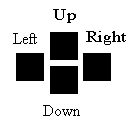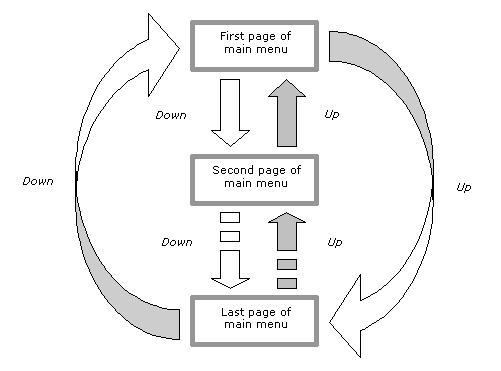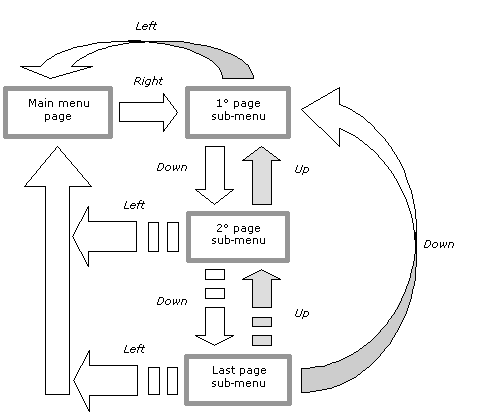

The Abilis CPX frontal panel lodges a floppy disk drive, a power switch and an MfIde2 equipment.
The MfIde2 is equipped of one LCD display, five push buttons, four leds, a Compact Flash and one Chip Card reader/writer.
The LCD Display and the indicators give information about the Abilis CPX working mode, while the push buttons provide some utility functions described.

Figure 1. Front panel.
 Power - (Power switch)
Power - (Power switch)
If pressing the Power switch the leds do not light on, control that the power cable is
working and connecting the Abilis CPX to the current tap. The user should also check whether the tap
supplies the required voltage (220V). If, after executing all the previous verifications, the Abilis
CPX didn't switch on, please contact the assistance.
 LED 1, 2, 3, 4 - (Power and Abilis CPX works indicators)
LED 1, 2, 3, 4 - (Power and Abilis CPX works indicators)
All leds are switched on, immediately after Abilis CPX has been started through switch Power.
If, after pressing the Power switch, the leds are not switched on, control that the power cable is working and connecting
the Abilis CPX to the current tap. The user should also check whether the tap supplies the required voltage (220V).
If, after executing all the previous verifications, the Abilis CPX didn't switch on, please contact the assistance.
The green LED 4 lightens every second, when the Abilis CPX starts to working, after the software loading phase.
 Up, Down, Right, Left - (Menu selection)
Up, Down, Right, Left - (Menu selection)
Every time the button Up, is pressed, the display will show the previous menu. By pressing it a lot of times, all
the menus will be shown in a cyclic way.
Every time the button Down, is pressed, the display will show the next menu. By pressing it a lot of times, all
the menus will be shown in a cyclic way.
Every time the button Right, is pressed, the display will show the sub-menu.
Every time the button Left, is pressed, the display will go back to the menu.
Refer to section Use of the display and function keys (Up, Down, Right, Left and OK),
for a more detailed description.
 OK - (Confirmation key)
OK - (Confirmation key)
Pressing key OK it is possible to access information about the menu currently showed on the LCD display. Moreover for those menus,
that requires a confirmation, by pressing the OK key, an affirmative answer will be given to the request showed on the LCD display.
Refer to section Use of the display and function keys (Up, Down, Right, Left and OK),
for a more detailed description.
 Liquid Crystals Display.
Liquid Crystals Display.
The LCD is able to visualize two lines of sixteen alphanumeric characters. In order to allow an easy read
is necessary that the environment is sufficiently illuminated. If the display is not clearly legible, it is necessary to
change the observation angle, moving in horizontal and/or vertical sense.
 Compact Flash.
Compact Flash.
On CF based systems, for a correct Abilis CPX working mode it is mandatory that the Compact Flash, containing the Abilis CPX software,
is inserted.
Moreover it cannot be inserted/extracted while the power is on, otherwise its content will be definitively damaged. Be sure to have
switched off the system before inserting/extracting the Compact Flash.
 Floppy disk drive.
Floppy disk drive.
On Floppy based systems, for a correct Abilis CPX working mode it is mandatory that the disk, containing the Abilis CPX software,
is inserted.
The inserted disk must be NOT WRITE PROTECTED, contrary Abilis CPX will start regularly, but it won't be possible to
save either new configuration or log files.
The floppy disk is not write protected if the write enable "window" is closed. The floppy disk is write protected if it is opened.
On HD/CF based systems, the floppy disk can be used for configuration and Log files backup/restore operations. Refer to section
System updating and restarting for more details about these features.
At the Abilis CPX start, the display visualizes the Messages Menu which shows on the first row the product name, on the second the software version currently in use.
The use of Up, Down, Right, Left and OK push buttons is the following:
The picture shows how to scroll the menus.

Pressing the Right key it is possible to access sub-menus.
The picture shows how to enter and leave a sub-menu, as well as how to scroll the sub-menu.

 Messages Menu - Abilis CPX version and system messages.
Messages Menu - Abilis CPX version and system messages.
The first row of the Messages Menu visualizes the system name, while the second shows informative messages about the system working mode. For example, after resources activation, during which it is visualized the software version, the message "START SYSTEM" will be shown to signal that Abilis CPX from that moment is regularly working:

The informative messages are displayed if, on the display, the Messages Menu is active. If one of the following menus is active, only eventual messages of errors or alarms will be displayed.Every time an informative message or an alarm is shown, pressing the OK key is possible to visualize again name and version of the product.
 State Menu of the link level ports
State Menu of the link level ports
This menu allows displaying the status of the link level ports. Pressing the Right key, it is possible to access the first page of the menu, pressing successively the Down key all the other eventual pages will be shown in a cyclic way. Only the active and correctly "RUNNING" ports are shown. Each page shows information about two ports:

Where:
If no Link ports are running, the following message will be shown:

Press the Left key to go back to the main Menu.
Maintaining the display on a page, every second the state of the port(s) shown on that page is refreshed.
 State Menu of the protocol ports
State Menu of the protocol ports
This menu allows displaying the status of the protocol ports. Pressing the Right key, it is possible to access the first page of the menu, pressing successively the Down key all the other eventual pages will be shown in a cyclic way. Only the active and correctly "RUNNING" ports are shown. Each page shows information about two ports:

Where:
If no protocol ports are running, the following message will be shown:

Press the Left key to go back to the main Menu.
Maintaining the display on a page, every second the state of the port(s) shown on that page is refreshed.
 State Menu of the VOICE ports
State Menu of the VOICE ports
This menu allows displaying the status of the VOICE ports. Pressing the Right key, it is possible to access the first page of the menu, pressing successively the Down key all the other eventual pages will be shown in a cyclic way. Only the active and correctly "RUNNING" ports are shown. Each page shows information about twenty ports:

Where:
If no VOICE ports are running, the following message will be shown:

Press the Left key to go back to the main Menu.
Maintaining the display on a page, every second the state of the port(s) shown on that page is refreshed.
 State Menu of the ISDN PRIMARY channels
State Menu of the ISDN PRIMARY channels
This menu allows displaying the state of ports and ISDN primary rate channels. Pressing the Right key, it is possible to access the first page of the menu, pressing successively the Down key all the other eventual pages will be shown in a cyclic way. Only the active and correctly "RUNNING" ports are shown.
Each ISDN PRI port requires two pages, in the first one Level 1, Level 2 states and "Slips" are shown, in the second is shown each B-channel state.
First page:

Where:
Pressing the Right key, the second page will be shown:

Where:
Pressing the Down key the next port will be shown.
If no ISDN-PRI (EPQ931) ports are running, the following message will be shown:

Press the Left key to go back to the main Menu.
Maintaining the display on a page, every second the state of the port(s) shown on that page is refreshed.
 State Menu of the ISDN BASIC RATE channels.
State Menu of the ISDN BASIC RATE channels.
This menu allows displaying the state of ISDN Basic Rate channels. Pressing the Right key, it is possible to access the first page of the menu, pressing successively the Down key all the other eventual pages will be shown in a cyclic way. Only the active and correctly "RUNNING" ports are shown.
Each page shows information about 4 pair of channels:

Where:
If no ISDN-BRI (Q931/EBQ931) ports are running, the following message will be shown:

Press the Left key to go back to the main Menu.
Maintaining the display on a page, every second the state of the port(s) shown on that page is refreshed.
 Menu of compression statistics
Menu of compression statistics
This menu allows displaying the compression statistics of the protocol ports. Pressing the Right key, it is possible to access the first page of the menu, pressing successively the Down key all the other eventual pages will be shown in a cyclic way. Only the active and correctly "RUNNING" ports are shown. Each page shows information about two ports:

Where:
If no protocol ports type is running, the following message will be shown:

Press the Left key to go back to the main Menu.
Maintaining the display on a page, every second the state of the port(s) shown on that page is refreshed.
 Menu of System Utilities
Menu of System Utilities
This menu can execute operations related to system management, such as enabling/disabling the acoustic signal, system restart or saving the Events Log (Debug Log), or the current configuration. Pressing Right key the user accesses the first page of the menu, pressing the Down key all the other pages are visualized in a cyclic way.
Enabling/disabling the acoustic alarm signal:
The purpose of this utility command is the same of the SOUND DISABLE and SOUND ENABLE commands that are available through the Control Port command-line interface.
If the signal is already enabled, the following message will be shown:

If the signal is already disabled, the following message will be shown:

The purpose of this utility command is the same of the RESTART SYSTEM command that is available through the Control Port command-line interface.
The following message will be displayed:

Saving the Events Log (Debug Log):
The purpose of this utility command is the same of the SAVE DEBUG command that is available through the Control Port command-line interface.
The following message is displayed:

Saving the current configuration:
The purpose of this utility command is the same of the SAVE CONF command that is available through the Control Port command-line interface.
The following message is displayed:

Creating a backup copy of the current configuration:
The purpose of this utility command is the same of the SAVE CONF BACKUP command that is available through the Control Port command-line interface.
The following message is displayed:

Creating copy of configuration and Log files on floppy disk:
The purpose of this utility command is the same of the CONFLOG BACKUP command available through the Control Port command-line interface.
![]() The command is available on HD/CF based system only.
The command is available on HD/CF based system only.
The following message is displayed:




Where:
Copying configuration files from floppy disk:
The purpose of this utility command is the same of the CONFLOG RESTORE command available through the Control Port command-line interface.
![]() The command is available on HD/CF based system only.
The command is available on HD/CF based system only.
The following message is displayed:




Where:
The purpose of this utility command is the same of the SYS FLPFORMAT command available through the Control Port command-line interface.
![]() The command is available on HD/CF based system only.
The command is available on HD/CF based system only.
The following message is displayed:

 Menu of alarms displaying
Menu of alarms displaying
The purpose of this menu is the same of the ALARM VIEW command available through the Control Port command-line interface.
It displays a list of those ports where an alarm event occurred. Being the alarm condition checked every 30 seconds, it is possible that 30 seconds could pass from the moment the port starts to correctly work again and to the one when the alarm event ends.

Where:
If there are no ports in alarm condition, the following message will be shown:

Maintaining the display on a page, every second the state of the port(s) shown on that page is refreshed.
Do not forget that this menu shows only those ports, whose parameter "LOG:" is set to "A", i.e. the periodic alarm event condition detection is requested.
 Menu of alarms management
Menu of alarms management
This menu allows working on those ports, which are in an alarm condition not recoverable automatically but only manually. The most frequent cases are the SDLC, HDLCT and MLM/Slink ports in their STOPPED state: because of the error type they have to be manually reset.
In such cases, if the ports parameter "LOG:" is set to "A", those ports will be contained in the "alarm list" and they can be reset from the Menu of alarms management.
The result is the same as the ALARM RESET command is executed through the control port and the command INIT PO: is sent to all the alarmed ports.